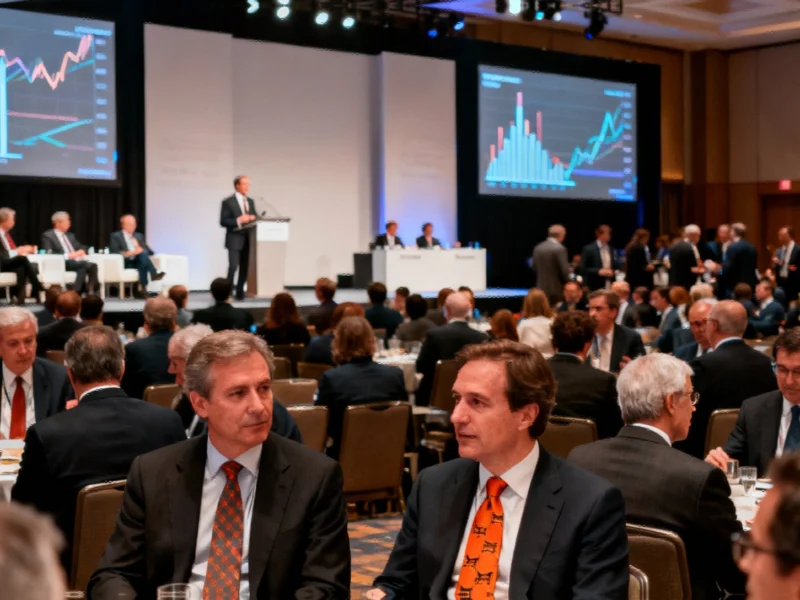Institutional Adoption Accelerates for Tokenized Assets
The recent Digital Asset Week conference in London revealed significant momentum toward tokenized money market funds (TMMFs) and digital assets across major financial institutions, according to reports from the event. Industry leaders from Goldman Sachs, JPMorgan, HSBC, and Franklin Templeton indicated that real-world asset tokenization has moved beyond experimental phases into production implementation.
Tokenized Money Market Funds Lead Institutional Charge
Sources indicate that tokenized money market funds dominated conference discussions, with panelists highlighting their advantages over traditional funds. TMMFs reportedly offer greater collateral mobility, can be posted atomically, preserve yield, and eliminate the need for redemption into cash. Analysts suggest these funds are bypassing many frictions that plague today’s collateral ecosystem while enabling entirely new business models built on real-time liquidity.
The conference revealed that the focus has shifted from whether to implement tokenization to how to optimize implementation, with interoperability emerging as the critical factor separating successful projects from failures. According to reports, no one wants to get stuck in walled gardens on what industry participants are calling “token islands.”
Major Sandbox Demonstration Shows Production Readiness
The Global Digital Finance Industry Sandbox, powered by Ownera’s FinP2P technology, reportedly demonstrated that European TMMFs can be delivered now with legal certainty. The sandbox involved over 30 top-tier traditional finance and digital financial market infrastructure firms with six production use cases. Industry experts suggest this represents a significant step forward for sandbox implementations in financial services.
Natasha Benson, COO and CFO of Ownera, stated that “hosting the GDF Industry Sandbox was a monumental collaborative effort, bringing together some of the best-in-class market participants, custodians, and technology providers from across the industry.” The GDF TMMF Report will be published in November, with the sandbox scheduled for mobilization in the US market in January 2026.
Stablecoins Emerge as Web3’s “Killer App”
The report states that stablecoins have emerged as the “killer app” of Web3, with the potential to transform traditional banking models. With yield available to stablecoin owners through collateral staking, analysts suggest the traditional savings market could be fundamentally disrupted as money chases protocol inflation at velocities difficult for institutions and central banks to predict or control.
Ten major banks including Bank of America, Deutsche, Goldman Sachs, and UBS are reportedly jointly exploring issuing a stablecoin pegged to G7 currencies. Meanwhile, UK Finance has launched an industry pilot project for tokenized deposits with banks including Barclays, HSBC, and Lloyds Banking Group. These market trends indicate significant institutional movement toward digital currency solutions.
Wallet-Based Economy Reshaping Financial Services
Franklin Templeton’s Sandy Kaul shared insights about digital asset markets moving customers from an “account base” to a “wallet base,” a transition that will involve significant digital transformation for traditional finance players. According to her analysis, this shift represents one of the most substantial related innovations in financial services infrastructure.
Standard Chartered’s Waquar Chaudry added that “the rails are going to be common, we’re moving into a wallet based economy,” noting that custodians are evolving from back-office functions toward middle-office roles due to enhanced capabilities that can be built into digital systems. These developments reflect broader industry developments in digital infrastructure.
Goldman Sachs and JPMorgan Outline Strategic Positions
In what was described as a “poacher turned gamekeeper” panel, Goldman Sachs’ Matt McDermott questioned Apex’s founder and CEO Peter Hughes about how tokenized MMFs and programmatic stablecoins are rewiring institutional treasury operations. Apex, which recently acquired Tokeny, is reportedly positioning for what they call the “avalanche” of tokenization projects from traditional finance.
JPMorgan’s Scott Lucas moderated a panel on “the tokenizing of everything,” concluding that 24/7 trading with instantaneous settlement through wallet-based systems will become standard. Lucas reportedly stated that flagship products will be tokenized money market funds allowing investors to remain permanently in yield-bearing instruments while converting immediately to digital cash when needed. However, Lucas also explained why JPMorgan will focus on crypto trading rather than custody, citing the latter as a low-margin business with limited revenues and significant downside risk.
HSBC Expands Tokenization Beyond Traditional Assets
Beyond tokenizing fixed income, repo, funds, and ETFs, HSBC has moved to tokenize gold, driven by client demand. As one of the world’s largest gold custodians, HSBC’s tokenized gold initiative represents a significant expansion of tokenization into precious metals. HSBC’s John O’Neill noted that “looking at the gold price today it looks like a pretty shrewd position for tokenized assets,” suggesting that recent technology applications are creating new value opportunities.
UK Government Position Receives Mixed Reactions
UK Economic Secretary to the Treasury Lucy Rigby delivered an upbeat account of government actions on digital assets, including stablecoins and the Digit, the UK digital gilt. The government has announced it will select its digital infrastructure partner by December 2025 and move to pilots. However, industry players reportedly expressed less optimism, suggesting the UK government is stuck in continuous consultations and lacking central leadership despite the country’s early dominance in global fintech.
As traditional finance institutions accelerate their tokenization roadmaps, those slow to adapt reportedly risk being left behind. However, analysts suggest the pace, while fast, represents a controlled ascent rather than a reckless rush. The evolution of digital audio workstation technology provides an interesting parallel for how specialized digital tools can transform traditional industries.
With major resource nations also making strategic moves in related innovations, the intersection of digital finance and real assets continues to create new opportunities and challenges for global financial markets. Industry participants are watching these developments closely as traditional finance continues its digital transformation journey.
This article aggregates information from publicly available sources. All trademarks and copyrights belong to their respective owners.



